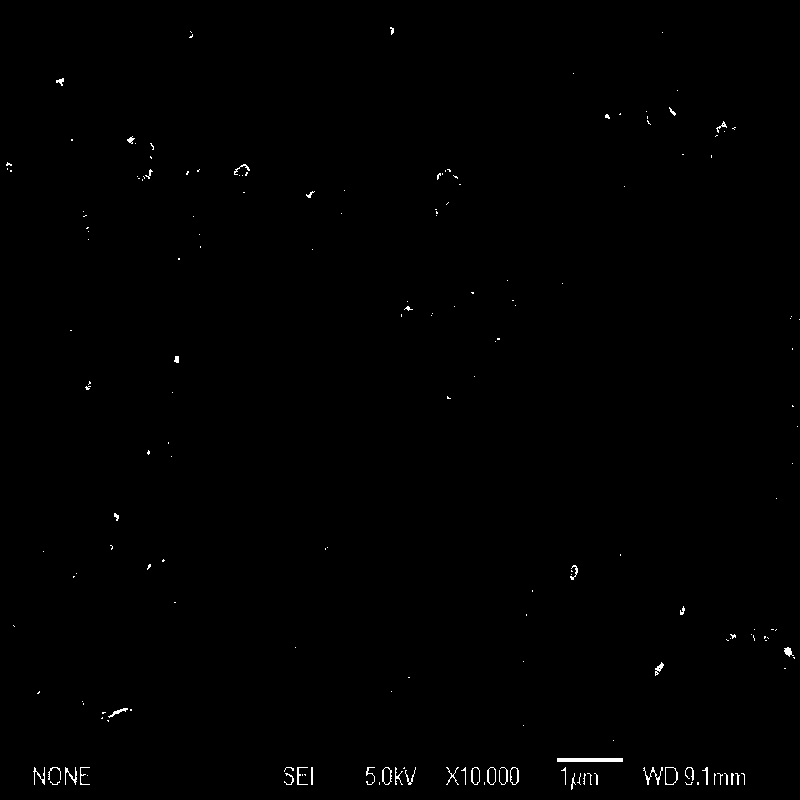Chemical palladium immersing solution
A palladium immersion and chemical technology, which is applied in the field of chemical immersion (immersion) palladium solution, can solve the adverse effects of surface palladium layer inhomogeneity chemical gold plating, difficult to control the thickness and other problems, to improve the solderability and conductivity of the coating, life expectancy The effect of shortening and uniform coating
- Summary
- Abstract
- Description
- Claims
- Application Information
AI Technical Summary
Problems solved by technology
Method used
Image
Examples
Embodiment 1
[0044] Bath composition
[0045] Pd(NH 3 ) 2 Cl 2 / g·L -1 1.6 (as palladium)
[0046] Ethylenediamine / mL·L -1 50
[0047] Citric acid / g·L -1 15
[0048] OP-10 ml / L 0.01
[0049] Adjust the pH of the plating solution to 5.80 with ammonia water, and immerse the 20×30mm pre-nickel-plated printed circuit board in the plating solution for 30 minutes, and the temperature of the plating solution is 40°C. As a result, a flat palladium film with an average thickness of 6.7 μm was produced. The palladium film is observed under a 10000 scanning electron microscope, and it can be observed that the surface of the palladium film is even and smooth. At the same time, when the plating solution was cooled, the measured pH was 5.75, and the pH change was very small. The MTO of palladium is greater than 3.
Embodiment 2
[0051] Bath composition
[0052] Pd(NH 3 ) 4 Cl 2 / g·L -1 0.1 (as palladium)
[0053] Ethylenediamine / mL·L -1 40
[0054] Nitrilotriacetic acid / g·L – 1 20
[0055] Citric acid / g·L -1 2
[0056] OP-10 ml / L 0.1
[0057] Adjust the pH of the plating solution to 3.00 with ammonia water, and immerse a 20×30mm nickel-plated printed circuit board in the plating solution for 30 minutes, and the temperature of the plating solution is 40°C. As a result, a flat palladium film having an average thickness of 1.1 µm was produced. The palladium film was observed under a 10000 scanning electron microscope to be even and smooth. At the same time, when the plating solution was cooled, the measured pH was 2.95, and the pH change was very small. The MTO of palladium is greater than 4.
Embodiment 3
[0059] Bath composition
[0060] PdCl 2 / g·L -1 0.6 (calculated as palladium)
[0061] Ethylenediamine / mL·L -1 30
[0062] Ammonium chloride / g·L – 40
[0063] HNO 2 ml / L 0.2
[0064] The pH of the plating solution was adjusted to 5.79 with hydrochloric acid, and a 20×30mm nickel-plated printed circuit board was immersed in the plating solution for 30 minutes, and the temperature of the plating solution was 40°C. As a result, a flat palladium film with an average thickness of 2.1 μm was produced. The palladium film was observed under a 10000 scanning electron microscope to be even and smooth. At the same time, when the plating solution was cooled, the measured pH was 5.45, and the pH change was very small. The plating solution was operated continuously for 15 hours, the bath solution was stable, and the deposition rate was stable. The MTO ...
PUM
| Property | Measurement | Unit |
|---|---|---|
| Film thickness | aaaaa | aaaaa |
Abstract
Description
Claims
Application Information
 Login to View More
Login to View More - R&D
- Intellectual Property
- Life Sciences
- Materials
- Tech Scout
- Unparalleled Data Quality
- Higher Quality Content
- 60% Fewer Hallucinations
Browse by: Latest US Patents, China's latest patents, Technical Efficacy Thesaurus, Application Domain, Technology Topic, Popular Technical Reports.
© 2025 PatSnap. All rights reserved.Legal|Privacy policy|Modern Slavery Act Transparency Statement|Sitemap|About US| Contact US: help@patsnap.com


